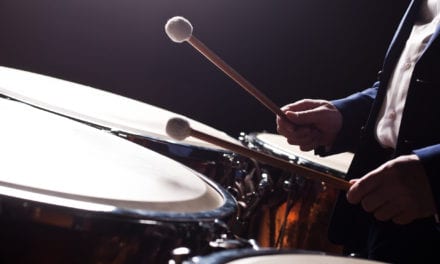By Stacy Hanson
A fit for all
The brand new Curtis Performance Hall at the Tsotsis Academic Center at Assumption College in Worcester, Massachusetts, was built to serve many needs. Class lectures, theatrical performances, choir concerts and movie showings all happen at the hall. And those many needs require vastly different acoustics.
To determine the right sound solution, the school leadership partnered with acousticians, architects, consultants and sound experts. They set out to determine how to create the best-sounding, best- looking space to accommodate the various needs of the students.
Solution for singers and speakers
Choral Director Michelle Graveline wanted a space where her choir could shine for audiences near and far. But the auditorium would also be used as a lecture hall.
“Spoken word is at the low end of reverberation time and choral performance is at the high end of reverberation,” explains Alex Bagnall, acoustician with Cavanaugh Tocci Associates, the acoustical consultants on the project.
“Early on, they asked about adjustability. We explored using drapes but the room wasn’t big enough to achieve a reverberation time that would be appropriate for choral music. That’s when the idea of electronically enhanced acoustics came up,” he says.
In order to hear what that might sound like, Bagnall suggested they visit another school where an electronic system was already in place. It was time for a field trip.
Hear it to believe it
When it comes to technology, sometimes you don’t understand it until you experience it. “We were trying to explain how an active acoustic system might just be the perfect fit,” says Ron Freiheit, Director of Acoustics at Wenger Corporation. Active acoustics includes a system of microphones and speakers that help project sound among musicians and into the audience. “We knew they needed to hear it to really understand it.” They invited Graveline and her team to Wartburg College in Waverly, Iowa, where Wenger’s Transcend Active Acoustic System is installed in Neumann Auditorium.
“What’s great about this system is that it gives facility managers the ability to enhance acoustic environments in virtually any space: performing arts centers, auditoriums, theatres, opera houses, arenas and worship spaces,” says Matt Hildebrand, Acoustics Product Manager at Wenger.“It’s high- performance and offers great flexibility.”
Flexibility includes presets to accommodate everything from a small concert setting to a medium-sized lecture hall to a large chapel simulation. Each preset is customizable and can be changed between uses with the touch of a few buttons.
“Going to Wartburg definitely helped,” Bagnall says.“The classical music crowd has an inherent distrust of all things electronic. They needed to hear that enhancements can be subtle and helpful.”
Created to be customized
Bagnall and his fellow acoustician Kent McKelvie worked with Wenger’s Hildebrand and Freiheit to determine how many speakers and microphones the space would need and where to position them. They opted for two microphones and 60 speakers placed strategically throughout the auditorium. They chose six custom presets, one for each of the most common needs in the space: lecture hall, small recital, medium recital, small hall setting, large hall setting and chapel.
“We worked with the architects to get the sound absorption distributed properly so the system could work with the room,” McKelvie explains.“Now it looks good and sounds good.”
“Most schools can’t afford to have a different venue for every different acoustical need so a system like this can satisfy everyone,” Freiheit says.
As a bonus, they were able to tap into the existing surround sound system in the auditorium. They use this mode when viewing movies for a more immersive sound.
Finishing touches
The final tuning stages involved bringing in different music sources, like a singer and a violinist, and adjusting the presets. The musicians using it need to get used to it and figure out how to use it to their advantage.
“We typically let the customer use it for awhile and then go back in six months and see if anything needs to be tweaked. It takes awhile to get a sense of what it is,” Freiheit says.
“Ideally, the casual visitor isn’t aware that there’s an acoustic system in the auditorium,” McKelvie says. “We just want them to think that everything they heard that night was amazing.”


